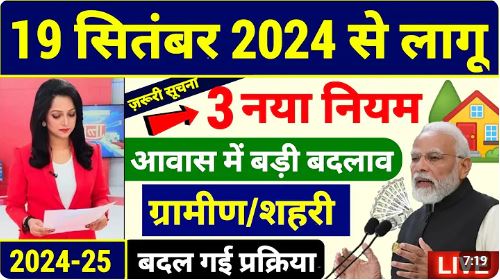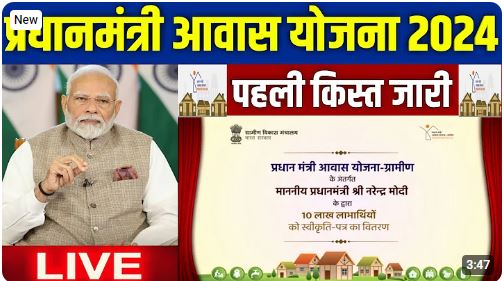PM Awas Yojana 2024
Click Here PM Awas Yojna Video link
1st Installment 32 Crore PM Awas Yojna 2024

यह भी पढ़े – TS POLYCET Result 2024, यहाँ से तुरंत डाउनलोड करें! अपना स्कोरकार्ड
PM Awas Yojana 2024 : A Step Towards Affordable Housing for All
Housing is one of the most basic human needs. For decades, millions of Indians, particularly in urban and rural poor communities, have struggled to secure proper shelter. The Pradhan Mantri Awas Yojana (PMAY) is the Indian government’s flagship initiative aimed at addressing this problem by providing affordable housing for all. Launched by Prime Minister Narendra Modi in June 2015, PMAY has since become a transformative scheme, bringing hope to many who had once dreamed of owning a home.
In this blog, we will explore what PM Awas Yojana is, its objectives, features, progress, and its impact on India’s socio-economic landscape.
What is PM Awas Yojana?
Pradhan Mantri Awas Yojana is a housing initiative focused on delivering affordable housing to the urban and rural poor across India. The scheme has two main components:
PMAY Urban (PMAY-U): Focuses on the housing needs of the urban poor, particularly slum dwellers, Economically Weaker Sections (EWS), Low-Income Groups (LIG), and Middle-Income Groups (MIG).
PMAY Rural (PMAY-G): Aimed at providing pucca (permanent) houses to the homeless and those living in dilapidated homes in rural areas.
The primary goal of PMAY is to ensure “Housing for All” by the year 2024, a vision that entails constructing millions of homes for the underprivileged across India.
Key Features of PM Awas Yojana
Several features of PMAY make it a comprehensive and inclusive housing initiative:
Subsidized Interest Rates: One of the biggest incentives under PMAY is the Credit Linked Subsidy Scheme (CLSS), which provides interest subsidies on home loans for eligible beneficiaries. Depending on the category (EWS, LIG, MIG), the subsidy ranges from 3% to 6.5% on home loans.
Focus on Women Empowerment: Under PMAY, houses are allotted in the name of the female head of the family or co-jointly with the male head. This promotes women’s ownership of property and empowers them economically.
Sustainability: The scheme promotes the use of eco-friendly and sustainable construction techniques. It encourages the use of materials and technologies that are energy-efficient, affordable, and durable.
Urban and Rural Coverage: The scheme aims to cover both urban and rural areas, recognizing the diverse housing challenges faced by the urban poor (particularly slum dwellers) and the rural population living in inadequate housing.
Public-Private Partnerships (PPP): The involvement of private sector developers has been encouraged to ensure the scheme’s goals are met effectively and within time. Various models of partnerships exist to leverage private investments and ensure cost-effective housing development.
Beneficiary Categories:
Economically Weaker Section (EWS): Annual income up to ₹3 lakhs.
Low-Income Group (LIG): Annual income between ₹3 lakhs and ₹6 lakhs.
Middle-Income Group-I (MIG-I): Annual income between ₹6 lakhs and ₹12 lakhs.
Middle-Income Group-II (MIG-II): Annual income between ₹12 lakhs and ₹18 lakhs.
Objectives of PMAY
The mission of PM Awas Yojana is to provide affordable housing for all by 2024, which is aimed at achieving:
Reduction in homelessness by providing low-cost housing to those who need it the most.
Development of basic infrastructure around the housing units, ensuring they are equipped with water supply, sanitation, and electricity.
Urban rejuvenation by addressing the housing needs of slum dwellers and transforming the urban landscape through the construction of safe and permanent homes.
Rural housing by replacing kutcha (mud) houses with pucca (permanent) houses, thereby improving the quality of life for the rural population.
Progress So Far
Since its launch in 2015, the PMAY has made remarkable progress in both urban and rural areas:
PMAY-Urban: As of 2023, over 1.12 crore houses have been sanctioned, with over 70 lakh houses completed, benefiting millions of urban poor families.
PMAY-Gramin: Over 2 crore houses have been constructed for rural families, providing them with safe and sustainable housing.
This progress has led to a visible transformation in urban slums and rural regions, uplifting the quality of life for millions of Indians.
Challenges and Way Forward
Despite its success, PMAY faces certain challenges, such as:
Land availability in urban areas, which often limits the construction of new housing units.
Delays in project execution due to bureaucratic hurdles, financial constraints, or the involvement of multiple agencies.
Awareness gap: Many potential beneficiaries, especially in rural areas, are unaware of how to avail the benefits of the scheme.
To overcome these challenges, the government needs to streamline approval processes, increase awareness campaigns, and foster greater public-private collaboration.
Conclusion
Pradhan Mantri Awas Yojana is more than just a housing scheme—it’s a mission to transform India’s housing landscape, provide security to millions, and uplift the standard of living for the economically weaker sections of society. The vision of “Housing for All” is not just about constructing buildings, but about building futures and providing dignity to every citizen, ensuring that every family has a safe, stable, and sustainable home to live in.
As India marches towards becoming a developed nation, PMAY remains a cornerstone of its social welfare programs, playing a crucial role in bridging the housing gap and bringing inclusive growth.
